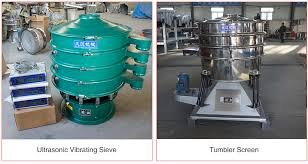Introduction
The tumbler vibrating screen is an advanced screening solution designed for efficient and precise separation of materials. Renowned for its versatility and high performance, it is widely used in various industries for processing powders, granules, and other particulate materials. This article provides a detailed overview of the tumbler vibrating screen, including its features, advantages, and applications.
What is a Tumbler Vibrating Screen?
A tumbler vibrating screen is a type of rotary sifter that uses a circular, tumbling motion combined with vibration to separate materials based on size and other characteristics. This motion mimics the action of hand sieving, allowing for effective classification and separation. The design of the Tumbler Vibrating Screen ensures that materials are screened thoroughly and gently, making it suitable for a variety of applications.
Key Features of Tumbler Vibrating Screens
- Circular Tumbling Motion:
- Description: The screen features a rotating deck that creates a tumbling action.
- Function: This motion helps to move materials across the screen, allowing for effective and uniform separation.
- Vibrating Mechanism:
- Description: Incorporates vibrating motors or eccentric weights to generate vibration.
- Function: Enhances the screening process by promoting material flow and separation.
- Multiple Decks:
- Description: Available with multiple screen decks.
- Function: Enables multi-stage separation and classification, increasing processing efficiency.
- Adjustable Vibration Settings:
- Description: Features adjustable vibration settings.
- Function: Allows customization of vibration intensity and direction to optimize performance for different materials.
- High-Quality Screen Mesh:
- Description: Made from durable materials like stainless steel.
- Function: Provides long-lasting performance and resistance to wear and tear.
- Large Screening Area:
- Description: Equipped with a spacious screen deck.
- Function: Facilitates high-capacity processing and efficient material handling.
- Durable Construction:
- Description: Built with robust materials and construction.
- Function: Ensures durability and reliability, even in demanding environments.
Advantages of Tumbler Vibrating Screens
- High Efficiency:
- Benefit: Delivers high-efficiency separation and classification, improving product quality and consistency.
- Versatility:
- Benefit: Suitable for a wide range of materials, including powders, granules, and coarse particles.
- Gentle Handling:
- Benefit: The tumbling and vibrating motion minimizes material degradation, making it ideal for fragile or high-value materials.
- Large Capacity:
- Benefit: The large screening area and multiple deck options allow for high-capacity processing and handling of large volumes.
- Customizable Performance:
- Benefit: Adjustable vibration settings and deck configurations provide tailored performance for specific applications.
- Low Maintenance:
- Benefit: Durable construction and easy-to-clean components result in reduced maintenance needs and operational costs.
Applications of Tumbler Vibrating Screens
- Food Industry:
- Application: Screens and classifies food powders, granules, and ingredients to ensure consistent product quality and safety.
- Pharmaceutical Industry:
- Application: Processes pharmaceutical powders and granules, providing precise separation to meet stringent quality standards.
- Chemical Industry:
- Application: Separates and classifies chemical powders and granules, enhancing material handling and processing efficiency.
- Mining and Aggregates:
- Application: Used for separating and classifying minerals, ores, and aggregates, improving processing and material quality.
- Recycling:
- Application: Screens and sorts recyclable materials such as plastics, metals, and paper, supporting efficient recycling operations.
- Plastic Industry:
- Application: Separates plastic pellets and granules, ensuring uniformity in plastic production processes.
Choosing the Right Tumbler Vibrating Screen
When selecting a tumbler vibrating screen, consider the following factors:
- Material Characteristics:
- Consideration: Assess the properties of the material, including particle size, density, and flow behavior.
- Screen Size and Capacity:
- Consideration: Determine the required screen size and capacity based on material volume and separation needs.
- Deck Configuration:
- Consideration: Choose the number of decks and mesh sizes according to the specific application and material requirements.
- Adjustability:
- Consideration: Look for features that allow for adjustment of vibration settings and screen motion to optimize performance.
- Durability:
- Consideration: Ensure the screener is made from high-quality, durable materials to withstand operational stresses and provide long-term reliability.
- Cost and Value:
- Consideration: Evaluate the cost relative to the features, performance, and potential return on investment.
Maintenance and Care
To ensure the optimal performance of a tumbler vibrating screen:
- Regular Inspections:
- Action: Inspect the screen mesh, vibrating mechanism, and other components regularly for signs of wear and damage.
- Cleaning:
- Action: Clean the screen deck and other parts frequently to prevent material buildup and maintain efficient operation.
- Lubrication:
- Action: Lubricate moving parts as necessary to reduce friction and wear.
- Adjustment and Calibration:
- Action: Periodically adjust vibration settings and screen configurations to maintain peak performance.
- Operator Training:
- Action: Train operators on proper handling, maintenance, and troubleshooting to ensure effective use and longevity.
Future Trends in Tumbler Vibrating Screens
- Technological Innovations:
- Trend: Integration of advanced technologies such as automation, real-time monitoring, and predictive maintenance for enhanced efficiency and performance.
- Customization:
- Trend: Increasing demand for customizable solutions tailored to specific industry needs and material characteristics.
- Energy Efficiency:
- Trend: Development of energy-efficient designs to reduce operational costs and environmental impact.
- Sustainability:
- Trend: Focus on sustainable manufacturing practices and materials to meet environmental regulations and corporate sustainability goals.
- Enhanced User Experience:
- Trend: Innovations aimed at improving user interfaces and control systems for better ease of use and maintenance.
- Integration with Industry 4.0:
- Trend: Adoption of Industry 4.0 technologies for improved integration, automation, and data analytics.
Conclusion
The tumbler vibrating screen is a highly effective solution for material separation and classification, offering high efficiency, versatility, and gentle handling. Understanding its features, advantages, and applications helps businesses make informed decisions when selecting this equipment. As technology advances, tumbler vibrating screens will continue to evolve, providing improved performance and customization options. Partnering with a reputable manufacturer ensures access to high-quality equipment and support, contributing to optimized material processing and operational success.




